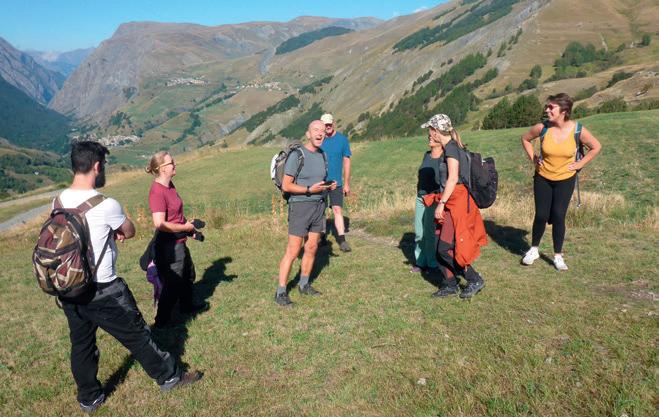Modern techniques to analyse ancient terraces

Researchers in the TerrACE project are using a variety of modern techniques to look at agricultural terraces in different locations across Europe, aiming to build a deeper picture of why they were initially created and what crops have been grown there at different periods, as Professor Antony Brown and Dr Daniel Fallu explain.
The history of agricultural terraces goes back thousands of years, and they have long been used as a means of improving productivity. One of the major theories behind why agricultural terraces were initially created is in response to population growth, as a way of meeting increased demand for food, yet Antony Brown, Professor of Geoarchaeology at the University of Tromsø Museum, believes this is not an entirely satisfactory explanation. “There’s not always a clear correlation between the construction of terraces and population increase,” he says. This is a topic Professor Brown is investigating as Principal Investigator of the TerrACE project, in which he and his team are investigating agricultural terraces from different periods at locations across Europe, including some which may have been created for reasons other than population growth. “Some of the more recent terraces we’re looking at date back to the 18th century. We think that these terraces were probably created to try and provide better food for the existing population,” he continues.
TerrACE project
These agricultural terraces have been relatively neglected in research, yet now the emergence of new techniques is opening up new possibilities. In particular a method called Lidar (Light Detection and Ranging) is revolutionising archaeology. “This involves the creation of a laser scan, which produces a high-resolution surface digital elevation model,” explains Professor Brown. The

project team is using Lidar and several other new techniques to build a deeper picture of why agricultural terraces were created, what was grown on them, and of why they may have been neglected at certain times before being re-used. “In the past we used pollen to look at what crops were grown on terraces, but now we use phytoliths, which are plant silica cells. We are also analysing ancient soil DNA (aDNA) from these agricultural terraces, which is the most risky and novel part of the project, as we didn’t really know whether any would be preserved,” outlines Professor Brown. “These new aDNA techniques haven’t really been applied yet on what you would call ancient soil sequences.”
This was one of the main drivers behind the wide geographic scope of the project, which spans a North-South transect, from terraces in Northern Europe right down to locations around the Mediterranean. This allowed
researchers to look at whether these new techniques would work better in some places than others, and to investigate the influence of the climate. “The received wisdom is that DNA is better preserved in areas with a mean annual temperature below 10ºC. That line roughly passes East-West through the Alps, so we wanted to look at sites both above and below that line across Europe,” says Dr Daniel Fallu, a postdoctoral researcher at the University of Tromsø Museum who is working on the project. Evidence from the project suggests received wisdom is not entirely accurate in this case, and that other factors are also involved. “Some of our best preserved sites were south of that North-South line. The mineralogical content of the soils seemed to be more important in the preservation of DNA than had perhaps been expected,” continues Dr Fallu.
Researchers have found that DNA is fairly well preserved at several sites in Southern



Europe, which will allow scientists to date agricultural terraces more accurately. Some of these terraces have been designated as Globally Important Agricultural Heritage Systems (GIAHS) by UNESCO, yet it has been difficult to establish how old they are, which Professor Brown says was a major motivating factor behind the project. “UNESCO want to preserve some of these terraces, as historic agricultural systems, because they have a high level of biodiversity,” he outlines. However, many terraces in southern Europe have been destroyed or damaged recently by heavy equipment, prompting a greater focus on these sites. “It’s possible to cultivate even quite steep slopes now using caterpillar tracks, which wasn’t feasible in the past with tractors. It’s becoming more practical to remove terraces,” continues Professor Brown. “That leads to the creation of very big fields, with a very high erosion risk. The evidence suggests that smaller fields don’t produce anywhere near as much erosion as large fields”

Soave wine reputedly the favourite of Emperor Augustus, Dr Fallu says evidence suggests they have also been used for different purposes at other periods. “The terraces date from around the turn of the 16th century. Analysis of DNA from the base of some of the terraces shows evidence of cannabis (hemp) cultivation. At the time Venice, in order to secure its fleet, had declared a monopoly on hemp production,” he
TerrACE
Terrace Archaeology and Culture in Europe
Project Objectives
The project seeks to apply modern geoarchaeological and botanical techniques to the investigation of agricultural terraces across Europe. TerrACE aims to uncover how and when these landscapes were created, as well as what crops were cultivated in these engineered landscapes.
Project Funding
This is a five-year European Research Council grant funded archaeological research project under the direction of Tony Brown of the Tromsø University Museum.
Project Partners
https://www.terrace.no/the-team
Contact Details
Tony Brown
Principal Investigator, Geoarchaeology Professor, University of Tromsø Museum Kvaløyvegen 30, Tromsø 9013, Norway E: antony.g.brown@uit.no W: https://www.terrace.no
“Some of the more recent terraces we’re looking at date back to the 18th century. We think that these terraces were probably created to try and provide better food for the existing population and in some cases control soil erosion.” Zhao, P., Fallu, D.J., Pears, B.R., Allonsius, C., Lembrechts, J., Van de Vondel, S., Meysman, F., van Wesemael, B., Six, J., Brown, A.G., Van Oost, K. 2023. Quantifying the soil properties relevant to SOC biogeochemical cycles by combining infrared spectroscopy with compositional data analysis. Soil & Tillage Research 231, 1055718 doi. org/10.1016/j.still.2023.105718
Preserving terraces
The project’s work will prove highly valuable in dating these terraces and providing more historical information about how they have been used and re-used over time, so strengthening the case for their preservation. While agricultural terraces are part of the tourist industry in some locations, and can be used to grow a wide variety of crops, they can’t support large volume agriculture. “This is why they’ve been left behind in a lot of regions,” explains Dr Fallu. Researchers have been able to produce plant lists for some of the terraces studied, showing which crops have been grown there, and Professor Brown says they are highly versatile. “Terraces are normally irrigated, therefore you can grow crops with higher water requirements. Terraces can be thought of in a way as allotments on slopes, you can grow almost anything on them,” he outlines. “A lot of terraces were used for what we would describe as horticulture. In Sicily, tomatoes have been grown pretty successfully on terraces, as well as peppers and aubergines.”
Researchers have also uncovered some interesting historical details in the project, such as the crops cultivated in the region of Soave in north-eastern Italy, which is famous for its agricultural terraces. While it is commonly assumed that these terraces were built to cultivate grapes for wine production, with
outlines. This illustrates the flexibility of terraces, which opens up the possibility of using them to meet demand for certain crops – although maybe not cannabis – as opposed to importing them from far-flung locations. “If terraces are maintained properly, and there is an adequate water supply, they can be used to cultivate a variety of crops, and increase what we today call ecosystem services,” says Professor Brown.
The project itself is nearing its conclusion, with Professor Brown and his colleagues writing up a number of papers, including several on the methodologies used in TerrACE. Alongside the dating methods, phytoliths and DNA analysis, the project team have also used a number of other innovative techniques, which will help guide future research into agricultural terraces.
“For example we have used luminescence dating in the project to look at how terraces are filled or re-worked over time. If soils have been mixed, we’ll get mixed luminescence signals between older and younger soils. Terraces are tricky to work with, but there are ways to make them less tricky,” says Dr Fallu. These novel methods could eventually be applied more widely in archaeology, while the project also has an applied dimension, related to heritage management and protection. “For example, the authorities in Soave can now add a bit more historical information about the terraces in their region,” explains Professor Brown.
Brown, A.G., Fallu, D., Cucchiaro, S., Alonso, M., Albert, R.M., Walsh, K., Pears, B.R., Scaife, R., Langdon, C., Tarolli, P., Snape, L., Lang, A., Ascough, P., Zhao, P., Oost, K., Waddington, C. (2023) Early Bronze Age Agricultural Terraces in NE England: morphology, dating, and cultural implications. Antiquity 97, 348-366.


Tony Brown has 40 years of experience in geoarchaeology. A trained geomorphologist and palynologist he is now pioneering the application of sedimentary ancient DNA to archaeology. Daniel Fallu is an archaeologist with a focus in ancient land use practices and microscopic soil analysis. His research emphasizes the wealth of “invisible” evidence contained within the soils of archaeological sites and how this evidence is impacted by the passage of time.


